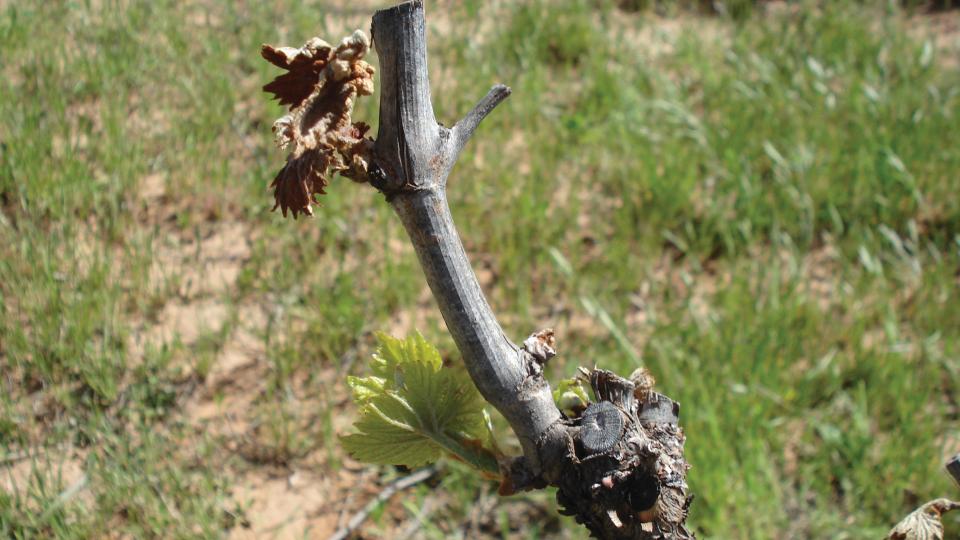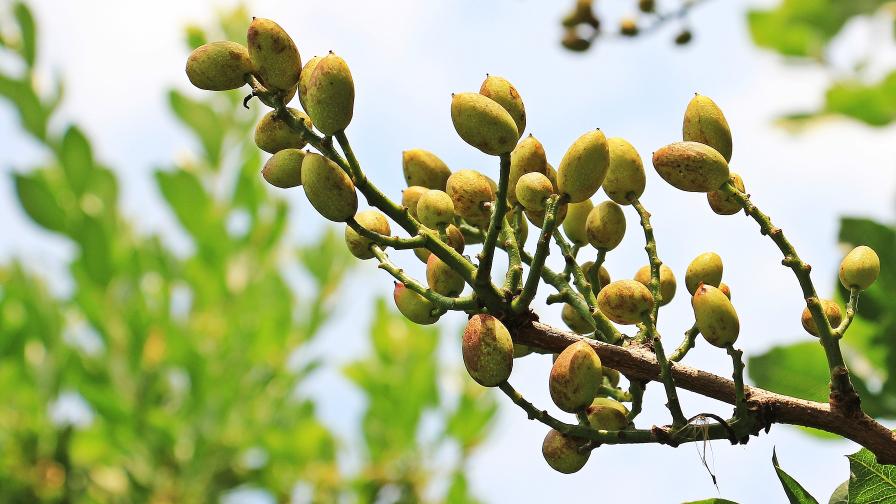How to Avoid Frost Injury in Vineyards

Frost-injured shoots (top) and uninjured shoots (bottom). (Photo: Ed Hellman)
Grapevines are sensitive to freezing temperatures during the growing season. Spring frost frequently damages opening buds and young shoots. In some regions, early fall frost can defoliate vines before harvest. There is some variation in temperature sensitivity among grape cultivars, but the LT50 (lethal temperature of 50% of subjects) of ‘Pinot Noir’ was reported to be 26°F for green swollen buds, 28°F at bud burst, 29°F at two-leaf stage, and 30°F at 4-leaf stage.
When cold temperatures are marginal or only persist for a short duration, damage will vary among buds and shoots within a vineyard and even within a single vine. Death of a primary shoot usually results in subsequent development of a shoot from the secondary growing point. Most cultivars do not have good (or any) flowering and fruit production from secondary shoots, although some grape cultivars, especially French or American hybrids, may produce 50% or more of a normal crop from secondary buds and basal buds. But growing conditions during flower cluster initiation in the previous year also influences fruitfulness of both primary and secondary shoots.
Strategies to manage frost injury to grapevines involve:
- Avoidance by reducing exposure to frost risk, and/or
- Protection by temperature modification

Bud burst of apical buds and suppression of basal buds in double pruning. Double pruning delays bud burst of basal buds that ultimately produce fruitful shoots. (Photo: Ed Hellman)
Avoiding Injury
The most important factor in avoiding frost injury is vineyard site selection. Cold air flows downhill, so mid-slope positions are warmest if cold air flow is unobstructed. Avoid planting in low areas where cold air settles. Trellis systems that position buds higher above ground level provide slightly warmer conditions for buds during radiation frost events than low-trained cordons or canes.
Another important consideration is timing of bud burst. Grape cultivars vary in date of bud burst by up to two weeks. Cultivars with early bud burst are at greater risk of frost injury, so this should be considered when selecting grape cultivars to plant and location within the vineyard. Plant cultivars with early bud burst in locations with the lowest risk of frost.
Vineyard management practices can also influence date of bud burst and reduce the risk of frost injury. Pruned vines have earlier bud burst than unpruned vines, so delayed pruning is an effective strategy for delaying bud burst and reducing risk of frost injury. Similarly, double-pruning delays bud burst of basal buds that ultimately produce fruitful shoots. The first step is to “rough prune” early, leaving long spurs with 6 to 10 buds. Apical buds burst earlier and suppress growth of basal buds. After frost risk has passed, or once basal buds begin to break, do a final pruning to cut back to two-bud spurs.
Application of soybean oil products to dormant buds has shown variable effects on delaying bud burst depending on grape variety and timing of sprays; the practice has been more effective on some hybrid grape cultivars than on ‘Concord’ or Vitis vinifera cultivars.
Floor management can be used to somewhat modify vineyard air temperatures. Closely mowed cover crops absorb more solar radiation than tall vegetation and release a small amount of heat overnight. Moist, firm bare soil absorbs and releases the most heat.
Relative Dates of Selected Cultivars’ Bud Burst
| Cultivar | Relative Time of Bud Burst (days)* |
| ‘Chenin Blanc,’ ‘Chardonnay’ | 0 |
| ‘Gewürtztraminer,’ ‘Viognier’ | 1 |
| ‘Pinot Blanc’ | 2 |
| ‘Pinot Gris,’ ‘Pinot Noir,’ ‘Merlot’ | 3 |
| ‘Petite Verdot,’ ‘Tennat’ | 5 |
| ‘Riesling,’ ‘Cabernet Franc,’ ‘Semillon’ | 6 |
| ‘Grenache,’ ‘Muscat Ottonel’ | 7 |
| ‘Sauvignon Blanc,’ ‘Syrah,’ ‘Tempranillo’ | 8 |
| ‘Carignane,’ ‘Marsanne’ | 10 |
| ‘Counoise’ | 13 |
| ‘Cabernet Sauvignon,’ ‘Mourvèdre’ | 14 |
*38-year average at French National Institute for Agricultural Research (INRA) Vassal Station – Languedoc (ENTAV-INRA, 1995)
Protecting Against Injury
Frost protection methods are active efforts to increase vineyard temperatures above injury levels and include wind machines, heaters, and sprinkler irrigation. Practicality and cost vary among these methods.
Wind machines are an effective method of frost protection in areas that experience atmospheric temperature inversions during radiation freeze events. The warmer air inversion layer typically occurs at about 40 to 50 feet above the vineyard floor, and 30-foot-tall wind machines with 18-foot blades mix the warmer air from the inversion layer with cooler air near the vineyard floor, raising the temperature around vines. Under favorable conditions, one wind machine can provide 1°F to 3°F of warming for about 10 to 12 acres. Helicopters have also been used over vineyards to push the warmer air of the inversion layer down to vineyard level. Wind machines and helicopters are ineffective in an advection freeze event because inversion layers do not form.
Heaters, usually fueled with natural gas, have been used in attempts to raise vineyard air temperature during freeze events, but are generally considered impractical due to inefficient heating of very large air volume and high fuel costs. Sometimes heaters are used in combination with wind machines in an effort to enhance their efficacy.
Overhead sprinklers or microsprinklers work on the basis of the heat of fusion; water changing from the liquid phase to solid (ice) phase releases a small amount of heat. Rapidly rotating sprinklers deliver a constant supply of water coating grapevine buds and shoots. The continuous freezing of water releases heat and raises the temperature of grapevine tissues. Although the method seems straightforward, a thorough understanding of the influence of dew point and wind speed on air temperature is necessary for effective use of this method. Improperly operated sprinklers can cause more damage than no treatment when unintentional evaporative cooling has the opposite effect of lowering air temperature. Large volumes of water are required for this method, making it impractical in many regions.










